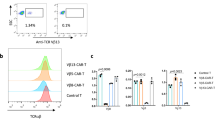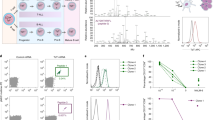Abstract
The 4-1BB glycoprotein is a member of the tumor necrosis factor receptor superfamily1–4 and binds to a high-affinity ligand (4-1BBL) expressed on several antigen-presenting cells such as macrophages and activated B cells5,6. Expression of 4-1BB is restricted to primed CD4+ and CD8+ T cells7, and 4-1BB signaling either by binding to 4-1BBL or by antibody ligation delivers a dual mitogenic signal for T-cell activation and growth8–12. These observations suggest an important role for 4-1BB in the amplification of T cell-mediated immune responses. We now show that administration of anti-4-1BB monoclonal antibodies can eradicate established large tumors in mice, including the poorly immunogenic Ag104A sarcoma and the highly tumorigenic P815 masto cytoma. The immune response induced by anti-4-1BB monoclonal antibodies is mediated by both CD8+ and CD4+ T cells and is accompanied by a marked augmentation of tumor-selective cytolytic T-cell activity. Our data suggest that a similar approach may be efficacious for immunotherapy of human cancer.
This is a preview of subscription content, access via your institution
Access options
Subscribe to this journal
Receive 12 print issues and online access
$209.00 per year
only $17.42 per issue
Buy this article
- Purchase on Springer Link
- Instant access to full article PDF
Prices may be subject to local taxes which are calculated during checkout
Similar content being viewed by others
References
Smith, C.A., Farrah, T. & Goodwin, R.G. The TNF receptor superfamily of cellular and viral proteins: Activation, costimulation and death. Cell 76, 959–962 (1994).
Armitage, R.J. Tumor necrosis factor receptor superfamily members and their ligands. Curr. Opin. Immunol. 6, 407–413 (1994).
Kown, B.S. & Weissman, S.M. cDNA sequences of two inducible T-cell genes. Proc. Natl. Acad. Sci. USA 86, 1963–1967 (1989).
Mallett, S. & Barclay, A.N. A new superfamily of cell surface proteins related to the nerve growth factor receptor. Immunol. Today 12, 220–222 (1991).
Pollak, K.E. et al. 4-1BB T-cell antigen binds to mature B cells and macrophages, and costimulates anti-μ-primed splenic B cells. Eur. J. Immunol. 24, 367–374 (1994).
Schwarz, H., Valbracht, J., Tuckwell, J., Von Kempis, J. & Lotz, M. ILA, The human 4-1BB homologue, is inducible in lymphoid and other cell lineages. Blood. 85, 1043–1052 (1995).
Pollok, K.E. et al. Inducible T cell antigen 4-1BB. J. Immunol. 150, 771–781 (1993).
Goodwin, R.G. et al. Molecular cloning of a ligand for the inducible T-cell gene 4-1BB: A member of an emerging family of cytokines with homology to tumor necrosis factor. Eur. J. Immunol. 23, 2631–2641 (1993).
Alderson, M.R. et al. Molecular and biological characterization of human 4-1BB and its ligand. Eur. J. Immunol. 24, 2219–2227 (1994).
Hurtado, J.C., Kim, S.H., Pollok, K.E., Lee, Z.H. & Kown, B.S. Potential role of 4-1BB in T-cell activation. Comparison with the costimulatory molecule CD28. J. Immunol. 155, 3360–3367 (1995).
Pollok, K.E., Kim, S.H. & Kwon, B.S. Regulation of 4-1BB expression by cell-cell interactions and the cytokines, interleukin-2 and interleukin-4. Eur. J. Immunol. 25, 488–494 (1995).
DeBenedette, M.A. et al. Role of 4-1BB ligand in costimulation of T lymphocyte growth and its upregulation on M12 B lymphomas by cAMP. J. Exp. Med. 181, 985–992 (1995).
Schreiber, H. Tumor immunology. in Fundamental Immunology, 3rd edn. (ed. Paul, W.E.) p. 1143 (Raven, New York, 1993).
Ward, P.L., Koeppen, H., Hurteau, T. & Schreiber J. Tumor antigens defined by cloned immunological probes are highly polymorphic and are not detected on autologous normal cells. J. Exp. Med. 170, 217–232 (1989).
Chen, L. et al. Tumor immunogenicity determines the effect of B7 costimulation on T cell mediated tumor immunity. J. Exp. Med. 179, 523–532 (1994).
Li, Y., Hellstrom, K.E., Ashe-Newby, S. & Chen, L. Costimulation by CD48 and B7-1 induces immunity against poorly immunogenic tumors. J. Exp. Med. 183, 639–644 (1996).
Ellenhorn, J.D.I., Hirsch, R., Schreider, H. & Bluestone, J.A. In vivo administration of anti-CD3 prevents malignant progressor tumor growth. Science 242, 569–571 (1988).
Townsend, S.E. & Alison, J.P. Tumor rejection after direct costimulation of CD8+ T cells by B7-transfected melanoma cells. Science 259, 368–370 (1993).
Leach, D.R., Krummel, M.F. & Allison, J.P. Enhancement of antitumor immunity by CTLA-4 blockade. Science 271, 1734–1736 1996).
Walunas, T.L. et al. CTLA-4 can function as a negative regulator of T cell activation. Immunity 1, 405–413 (1994).
Yang, G., Hellstrom, K.E., Mizuno, M.T. & Chen, L. In vitro priming of tumor reactive cytolytic T Lymphocytes by combining IL-10 with B7-CD28 costimulation. J. Immunol. 155, 3897–3903 (1995).
Chen, L. et al. Costimulation of antitumor immunity by the B7 counterreceptor for the T lymphocyte molecules CD28 and CTLA-4. Cell 71, 1093–1102 (1992).
Seder, R.A. & Paul, W.E. Acquisition of lymphokine-producing phenotype by CD4+ T cells. Annu. Rev. Immunol. 12, 635–673 (1994).
Ladbetter, J.A. et al. Antibodies to Tp67 and Tp44 augment and sustain proliferation responses of activated T cells. J. Immunol. 135, 2331–2336 (1985).
Johnston, J.V. et al. B7-CD28 costimulation unveils the hierarchy of tumor epitopes recognized by major histocompatibility complex class I-restricted CD8+ cytolytic T lymphocytes. J. Exp. Med. 183, 791–800 (1996).
Author information
Authors and Affiliations
Rights and permissions
About this article
Cite this article
Melero, I., Shuford, W., Newby, S. et al. Monoclonal antibodies against the 4-1BB T-cell activation molecule eradicate established tumors. Nat Med 3, 682–685 (1997). https://doi.org/10.1038/nm0697-682
Received:
Accepted:
Issue Date:
DOI: https://doi.org/10.1038/nm0697-682
This article is cited by
-
Fcγ receptors and immunomodulatory antibodies in cancer
Nature Reviews Cancer (2024)
-
4-1BB immunotherapy: advances and hurdles
Experimental & Molecular Medicine (2024)
-
Therapeutic Strategies in BRAF V600 Wild-Type Cutaneous Melanoma
American Journal of Clinical Dermatology (2024)
-
Aktivierung von Immunzellrezeptoren statt Checkpointblockade
InFo Hämatologie + Onkologie (2023)
-
Engineered soluble, trimerized 4-1BBL variants as potent immunomodulatory agents
Cancer Immunology, Immunotherapy (2023)



